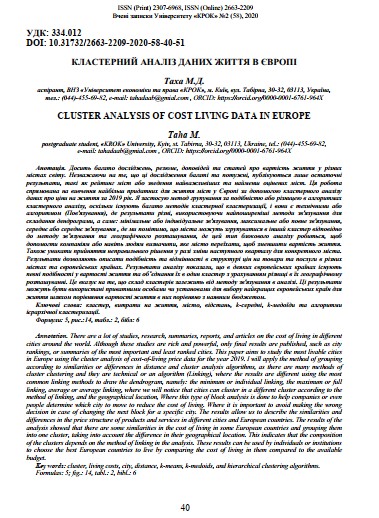CLUSTER ANALYSIS OF COST LIVING DATA IN EUROPE
DOI:
https://doi.org/10.31732/2663-2209-2020-58-40-51Keywords:
cluster, living costs, city, distance, k-means, k-medoids, hierarchical clustering algorithmsAbstract
There are a lot of studies, research, summaries, reports, and articles on the cost of living in different cities around the world. Although these studies are rich and powerful, only final results are published, such as city rankings, or summaries of the most important and least ranked cities. This paper aims to study the most livable cities in Europe using the cluster analysis of cost-of-living price data for the year 2019. I will apply the method of grouping according to similarities or differences in distance and cluster analysis algorithms, as there are many methods of cluster clustering and they are technical or an algorithm (Linking), where the results are different using the most common linking methods to draw the dendrogram, namely: the minimum or individual linking, the maximum or full linking, average or average linking, where we will notice that cities can cluster in a different cluster according to the method of linking, and the geographical location, Where this type of block analysis is done to help companies or even people determine which city to move to reduce the cost of living. Where it is important to avoid making the wrong decision in case of changing the next block for a specific city. The results allow us to describe the similarities and differences in the price structure of products and services in different cities and European countries. The results of the analysis showed that there are some similarities in the cost of living in some European countries and grouping them into one cluster, taking into account the difference in their geographical location. This indicates that the composition of the clusters depends on the method of linking in the analysis. These results can be used by individuals or institutions to choose the best European countries to live by comparing the cost of living in them compared to the available budget.
Downloads
References
Aboukadel, K. (2017), “Practical Guide To Cluster Analysis in R”. Unsupervised Machine Learning. Sthda Press. Edition 1.
Trevor, H. Robert, T. and Jerome, F. (2008), “The Elements of Statistical Learning”, Data Mining, Inference, and Prediction. Springer Press. Second Edition.
Sadanori, K. (2014), “Introduction to Multivariate Analysis”. Linear and Nonlinear Modeling Chapman & Hall Press.
. Richard, A. J. & Dean, W. W. (1998), “Applied Multivariate Statistical Analysis”, Prentice Hall Press. Four Edition.
Rafaela, C., D., M. & Alessandra, D., M. (2016), “The cost of living in the best livable cities in the world: a brief predictive quantitative analysis”. Int. J. Multivariate Data Analysis, Vol. 1, №1.
Numbeo (2019), “Is the world’s largest database of user contributed data about cities and countries worldwide”, Numbeo provides current and timely information on world living conditions including the cost of living, housing indicators, health care, traffic, crime, and pollution. 5,025,770 prices in 8,855 cities entered by 422,329 contributors and the information. Retrieved from: https://www.numbeo.com.


